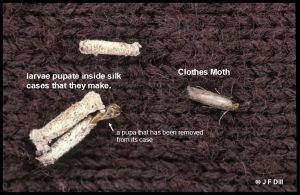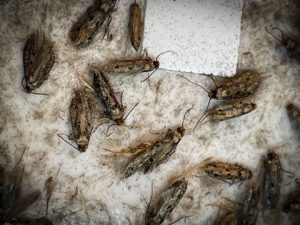Clothes Moths / Fungus Moths

Clothes moths, of which there are two common species (the Common/Webbing Clothes Moth and the Casemaking Clothes Moth), belong to the family Tineidae. They are small, and hold their wings roof-like over their body when at rest. Both of these species have adapted to feeding (in the caterpillar stage) on stored fabrics, especially wool, but many other natural fibers are at risk as well. They are considered a serious pest because of the amount of damage they can cause due to their larval feeding.

The family name of Tineidae is often labeled as “clothes moths” but another apt label for the family is “fungus moths” because the majority of the 3000+ species in 300 genera feed only on fungi, lichens, and detritus. Some species will also feed on stored grains. At least three species in the Nemapogon genus, for example, feed on shelf fungi as well as stored grains and possibly stored produce, rather than on clothing or animal furs; they are: N. cloacella, N. variatella and N. granella, the latter of which is known as the European Grain Moth or sometimes, “Corn Moth.” All three of those species are native to Europe but are now found in North America; they are believed to have been accidentally introduced. It is worth noting that occasionally people (including people in Maine) will catch Nemapogon and/or Niditinea moths indoors in the commercial clothes moth pheromone traps. One can see an example of that fact in the photo at left. Moths in those two groups are generally darker with wings that are very intricately patterned. More examples can be found in the corresponding links below at the BugGuide.net website.
..
Additional Information:
- Clothes Moths [pdf] (Cornell)
- Clothes Moths (University of Kentucky)
- Photos:
- Webbing Clothes Moth (Tineola bisselliella) (BugGuide.net)
- Casemaking Clothes Moth (Tinea pellionella) (BugGuide.net)
- Examples of fungus moth species that do not feed on clothes or fabrics:
- Nemapogon granella (European Grain Moth/Corn Moth) (BugGuide.net)
- Nemapogon cloacella (Cork Moth) (British Lepidoptera)
- Nemapogon variatella (BugGuide.net)
- Niditinea fuscella – Brown-dotted Clothes Moth / European House Moth (similar to Nemapogon granella in both appearance and in its non-clothing diet, even though one of its common names is brown-dotted clothes moth) (BugGuide.net)
